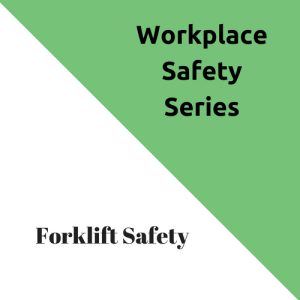Forklift Safety – Workplace Safety Series
 With nearly 100,000 injuries or fatalities due to forklift accidents in the U.S. each year, proper training is a critical part of forklift safety. Forklifts present a unique workplace hazard for many reasons: they weigh at least double the weight of the average car, they carry very heavy loads at heights, they work in areas close to people and other equipment, and they steer from the rear. It’s estimated that proper training can help prevent 70% of forklift accidents. To ensure that all operators are sufficiently skilled and knowledgeable, training standards are set by the Occupational Health and Safety Administration (OSHA) in the U.S. and the Canadian Standards Association (CSA) in Canada.
With nearly 100,000 injuries or fatalities due to forklift accidents in the U.S. each year, proper training is a critical part of forklift safety. Forklifts present a unique workplace hazard for many reasons: they weigh at least double the weight of the average car, they carry very heavy loads at heights, they work in areas close to people and other equipment, and they steer from the rear. It’s estimated that proper training can help prevent 70% of forklift accidents. To ensure that all operators are sufficiently skilled and knowledgeable, training standards are set by the Occupational Health and Safety Administration (OSHA) in the U.S. and the Canadian Standards Association (CSA) in Canada.
In the U.S. training standards for Powered Industrial Trucks (forklifts) require employers to develop and implement a training program based on:
– general principles of safe truck operation
– types of vehicle(s) being used in the workplace
– the hazards of the workplace created by the use of the vehicle(s)
– general safety requirements of the OSHA standard
OHSA requires that employees receive a combination of formal (eg. classroom lectures or video) and practical (eg. demonstration and hands-on exercises) training and that employers certify that each operator has received the training. Before an operator can use a forklift, the employer must evaluate his ability to safely use a forklift and declare him competent to operate it. Operators must be reevaluated by their employer at least once every three years. In the event of an accident or situation where the operator failed to safely operate the forklift, refresher training is required.
Click here for the offerings I have for you concerning Powered Equipment
The CSA Safety Standard B335-15 is a document which specifies the required elements of a forklift safety program as well as the requirements of vehicle design and construction, maintenance and inspection, safe operation, and operator training. It also makes recommendations regarding the qualifications for forklift safety trainers and maintenance technicians. The CSA Safety Standards were last updated in 2015 and this most recent edition included changes to operator training to ensure that the instruction is better understood and absorbed, and that operators are more thoroughly evaluated. CSA training requirements include theory, hands-on experience, knowledge verification, and practical evaluation. Although retraining is recommended every three years, employers are required to monitor performance on an ongoing basis and the provinces are able to legislate the frequency at which retraining should occur. Retraining is also required whenever new equipment is introduced, when the operating conditions have changed, when legislation has changed, or when skill or knowledge deficiencies are identified.
Although proper training is the most important factor in preventing workplace accidents, operators should also be aware of some of the top mistakes that lead to forklift accidents:
– Not being aware of load capacity – Carrying loads that are too heavy will make the vehicle unstable. The load capacity will be displayed clearly on the forklift so be sure to check this before starting work.
– Failing to plan your route – Forklifts often operate in congested areas and you need to be familiar with your driving path and look in advance for any obstacles that may be along your route.
– Operating with an unsecured load – You should always assess the stability of the load you’re carrying to make sure it doesn’t present any risks to you or other people and equipment. Take extra time to secure odd shaped loads and, if your load is extra wide, make sure to check that you have a wide enough path to navigate it through.
– Lack of communication – Forklifts operate in busy environments and to keep everyone safe, it’s important to let others know what you’re doing and where you plan to go. If you see someone else moving a load that may interfere with your work, be sure to take the time to stop and ask them how you can coordinate to work safely.
– Entering and exiting the forklift – Slips and falls are the most common workplace injury and these can happen when entering or exiting the forklift. Be sure to wear non-slip footwear before and while operating the forklift.
– Check your battery and fluid levels – You need to make sure your forklift is in proper working order in order to complete your job. Check that your battery is charged and that your levels of hydraulic fluid are adequate.
– Using a forklift that hasn’t been inspected – Forklifts should be inspected daily to ensure they’re in good working order.
– Driving too fast – Moving at a speed too fast for your vehicle or environment is a common cause of accidents. Pay attention to any speed limits or speed bumps, and whether your forklift’s speed is limited mechanically.
Operating a forklift safely starts with OHSA approved training that uses a combination of theory and practical hands-on training. However, safely operating a forklift requires that you’re always vigilant when operating the vehicle and pay close attention to detect any changes in the condition of your vehicle and the environment.
